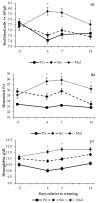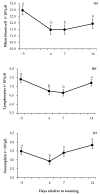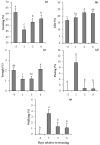Does Parity Influence the Magnitude of the Stress Response of Nellore Cows at Weaning?
- PMID: 37106884
- PMCID: PMC10135217
- DOI: 10.3390/ani13081321
Does Parity Influence the Magnitude of the Stress Response of Nellore Cows at Weaning?
Abstract
Most studies investigate the impact of stress at weaning on calves; however, little is known about the responses of cows, and whether they would differ according to parity. This study aims to investigate whether parity would influence the weaning stress response in beef cows. Thirty pregnant Nellore cows with their respective calves were randomly allocated to five paddocks and two females from each parity group were placed in the paddocks. There was an interaction (p < 0.05) between parity and evaluation days regarding cortisol, where on d + 7, the higher concentration was observed for multiparous cows. There was an interaction (p < 0.05) between parity and evaluation day for red blood cells (RBC), hematocrit (HCT), and hemoglobin (HB), whereby higher RBC counts on d + 4 were observed for multiparous cows. For HCT and HB, on all post-weaning collection days, higher values were observed for multiparous cows. The day of evaluation had an (p < 0.05) effect on all recorded behaviors, except for rumination (p > 0.05). Nellore cows, regardless of parity, underwent behavioral and physiological changes on abrupt weaning. Physiological parameters indicated that the magnitude of stress was greater in multiparous cows.
Keywords: behaviors; cattle; ceruloplasmin; cortisol; grazing; number of vocalizations; physiology; red blood cells.
Conflict of interest statement
The authors declare no conflict of interest.
Figures








References
-
- Weary D.M., Jasper J., Hötzel M.J. Understanding Weaning Distress. Appl. Anim. Behav. Sci. 2008;110:24–41. doi: 10.1016/j.applanim.2007.03.025. - DOI
-
- Ungerfeld R., Hötzel M.J., Quintans G. Changes in Behaviour, Milk Production and Bodyweight in Beef Cows Subjected to Two-Step or Abrupt Weaning. Anim. Prod. Sci. 2015;55:1281. doi: 10.1071/AN13453. - DOI
-
- Lynch E., McGee M., Earley B. Weaning Management of Beef Calves with Implications for Animal Health and Welfare. J. Appl. Anim. Res. 2019;47:167–175. doi: 10.1080/09712119.2019.1594825. - DOI
-
- Lynch E.M., McGee M., Doyle S., Earley B. Effect of Post-Weaning Management Practices on Physiological and Immunological Responses of Weaned Beef Calves. Ir. J. Agric. Food Res. 2011;50:161–174.
Grants and funding
LinkOut - more resources
Full Text Sources

